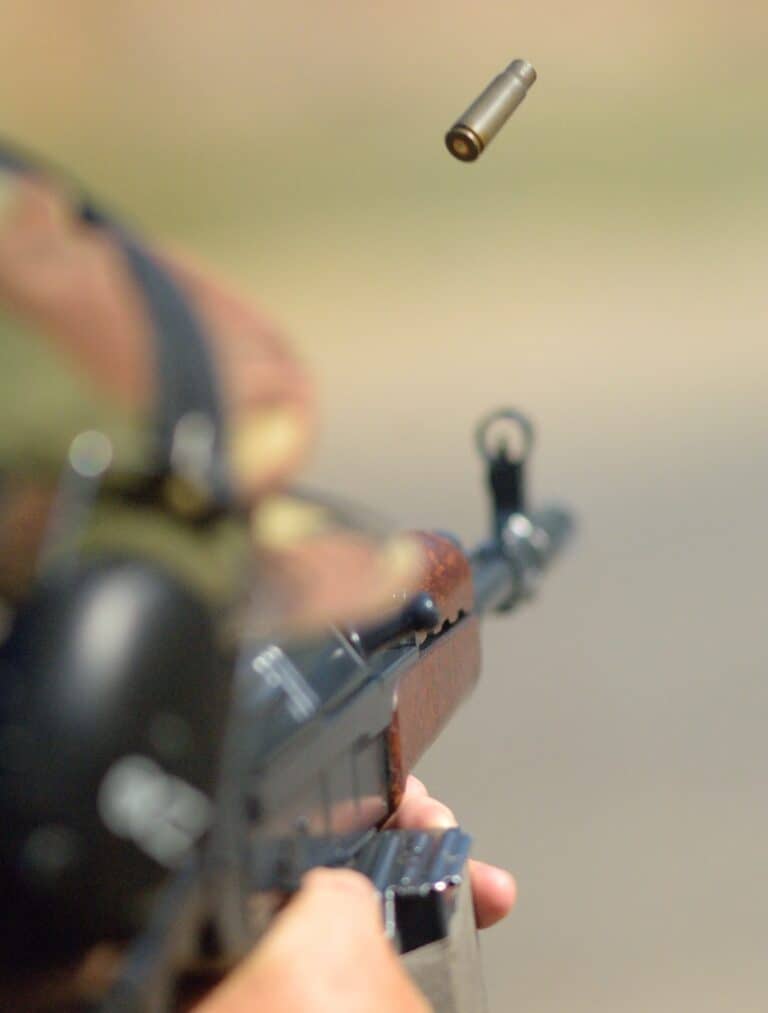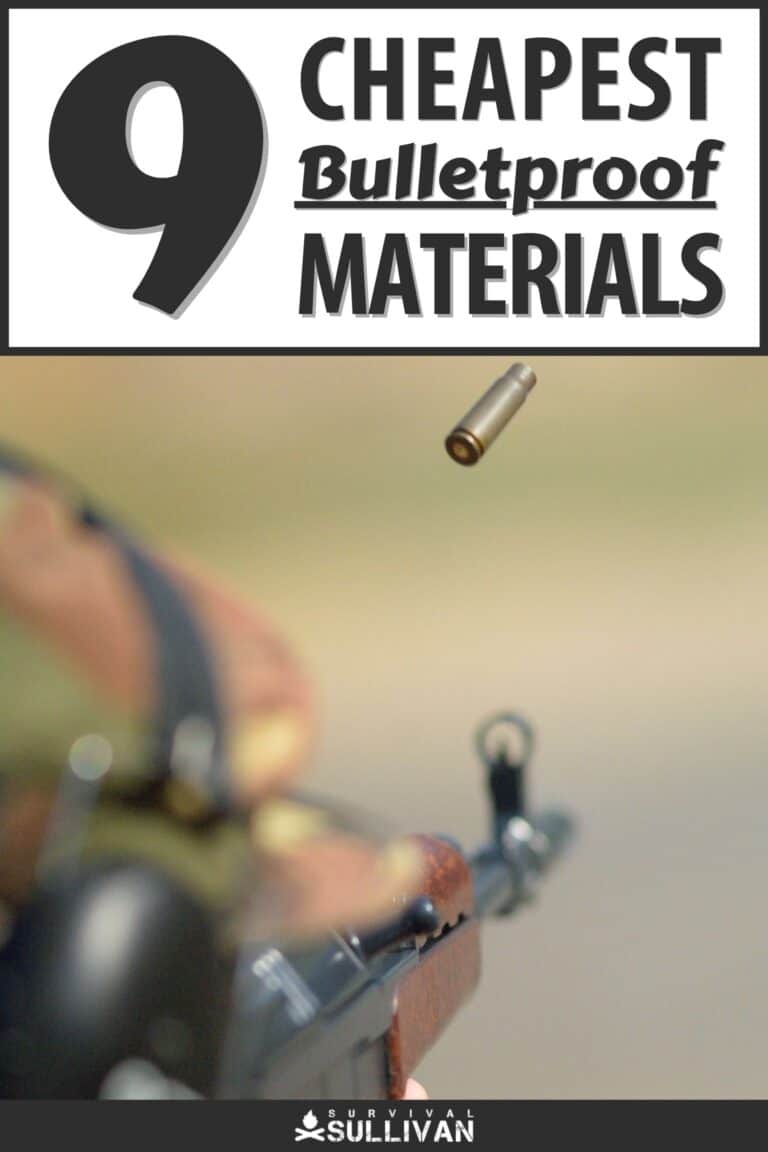The descriptors bulletproof and cheap typically don’t go together. If there is one practical problem you just cannot afford to mess up, it is the problem of bulletproofing something.

Whether it is yourself, your residence or a vehicle, if there is even a chance that you’ll be shot at you’ve got to know whatever you choose for protection is up to the task of stopping incoming fire.
But conventional bulletproof and bullet-resistant materials tend to be extremely expensive, making ballistic protection a possibility only for the financially well-off.
Luckily, there are actually quite a few options for cheap bulletproof materials. What are the cheapest?
Some of the cheapest bulletproof materials included dirt, sand, brick, cinder block, concrete, ceramic tile, thick wood, books and bullet resistant fiberglass. Each of these materials has various advantages and disadvantages.
You know the old saying: where there is a will there is a way, and that certainly applies to bulletproofing.
Whether you’re forced to come up with an improvised DIY solution, or you’re looking for purpose-made armor on an extremely limited budget, there’s definitely going to be something that will work for you. Keep reading, and I’ll tell you about nine materials that can do the job.
1. Dirt
Dirt is certainly the cheapest and also one of the most widely available bulletproof materials on Earth. It’s no exaggeration to say that a sufficient quantity of dirt will stop very literally any projectile imaginable.
Dirt is a popular choice for filling sandbags in military applications, like the so-called bastion walls made from hesco containers.
The downside of dirt is that it is quite heavy, and suitable only for use in protecting fixed locations; there’s no way to set it up to protect yourself as body armor.
But, if all you need to do is start building fortifications around your home or property, you can do a lot worse than filling up sandbags with soil and stacking them deep.

2. Sand
Sand, just like dirt, is another incredibly cheap and widely available resource that is highly bullet-resistant, although it takes a little more sand to stop a bullet compared to soil assuming it is packed densely.
That being said, this is a minor concern if you have plenty of sandbags or other containers to stack up. Also just like soil, sand is only good at protecting fixed structures or areas.
It cannot really be used as any sort of personal body armor, although a few enterprising individuals have piled sandbags on or in vehicles at strategic locations to provide hillbilly armor.
When you’re filling up sandbags with sand or with dirt, make sure you sift out any loose debris that could interfere with a nice, densely packed bag; that can compromise protection.

3. Brick
Bricks, and other masonry made from mud or clay, tend to be bulletproof- but only for a handful of shots!
Bricks are quite effective against even concentrated handgun fire for a time, though they tend to break down relatively quickly under a sustained barrage of rifle fire.
A double-layer brick wall, though, can provide significant protection for most intermediate caliber rifles and below. Brick also makes a good supplement to other protective measures like sandbags discussed above.
The trick with brick is to remember that the thicker it is, the better, and that it degrades quickly under gunfire. It is certainly good enough to protect you from many guns for a few shots, but sustained gun battles will render it useless.

4. Cinder Block
Cinder block is another readily available and cheap option that might be a component of your house already.
If not, they’re easy to source, and can provide good protection against handgun fire, though they aren’t as durable as you think when facing off against rifles, particularly.30 caliber rifles and above.
That being said, it is easy to reinforce cinder block using rebar and a fill of concrete, next up on our list, or even soil or dirt.
But just like brick, remember that the longer it is under fire, the lower and lower its protective value will be over time. Nothing lasts forever, especially not under a hail of gunfire!

5. Concrete
It’s hard to imagine anything that is stronger or surer than poured concrete. This is why it is the material of choice for various military fortifications like bunkers and tank traps the world over and has been for about a century or even longer.
Concrete of sufficient thickness will stop nearly anything in the realm of small arms, including massively powerful rifle and machine gun rounds.
Concrete is just the trick to truly fortify your home or other structure, but it is offset by its massive weight which can create structural problems.
Similarly, retrofitting it to a home can be cost-prohibitive from the work involved. But if you’re starting new construction, creating some fortified concrete walls is a great way to make any room or facing of your home bulletproof.

6. Ceramic Tile
Most gun-savvy folks already know that ceramic is a material of choice when it comes to body armor.
Only ceramic has the hardness and the unique properties to stop high-velocity rifle rounds in their tracks without a lethal amount of backface deformation or spalling which can be just as lethal as the bullet itself.
But, if you’ve gone shopping for high-end armor lately, you already know these ceramic plates are prohibitively expensive in most cases.
However, it is possible to get a meaningful (if much reduced) amount of ballistic protection from common ceramic floor or wall tiles.
Layering these tiles into a thick “sandwich,” or creating a strike face of sorts out of them on another sturdy material, creates a sort of composite armor that can be impressively bullet resistant or even bulletproof, but only for one or two hits over a large area.

7. Thick Wood
Like most other materials, if you can put enough wood in the path of a bullet, you’ll stop it. Most folks have enough good sense to take cover behind a tree, and thick trunks or enough planks or boards stacked up will prove similarly bullet resistant.
The exact degree of resistance you get is dependent upon the type of wood; most hardwoods are a better choice than softwoods.
Although not nearly as quickly as masonry in some cases, wood will also break down under sustained fire, significantly reducing its protective value.
If you did nothing else but double- or triple-layer 2x4s in a wall where you wanted protection in your home, you’d be off to a good start one that could easily be reinforced with other materials to make effective composite armor.

8. Books
This is bound to be one of the most surprising entries on this list! Yes, it is true that you can use books as improvised armor.
Specifically, the dense, fibrous nature of books makes them surprisingly effective at stopping bullets, particularly handgun rounds, though they can degrade certain intermediate rifle calibers.
Think of the book like a strike face itself, with the front or back cover being the side presented towards the incoming fire. Definitely not the edge, as the bullet can slip between the pages to more easily pierce the book!
This is an old gun fighters’ trick from way back: a strategically placed bookcase in your home can make a great cover point if you want to lock down a hallway or room.
As long as you are taking cover on one narrow end or the other (that is on either side of the books’ covers) and the books on the shelf are tightly packed you are good.
It does not take as many books as you might think stacked side by side to be truly bulletproof!
Also, this is the perfect opportunity to place ceramic tiles on the far ends to serve as a sacrificial strike face or baffle of sorts that can seriously disrupt an incoming round before it hits the books.

9. Bullet-Resistant Fiberglass
If you want to look at legitimate, commercially-available bulletproof material, bullet-resistant fiberglass is usually the cheapest.
Used in a variety of applications, from vehicles to residential and even business structures, bullet-resistant fiberglass can be used to form a wall as-is, or used as an armor component that is concealed beneath common materials.
This is going to be the most expensive option on this list by far, but if you want the “real thing” it is the cheapest option, and also highly adaptable and customizable even while on the job site. This is in stark contrast to concrete or steel armor.
Bullet-resistant fiberglass panels are available generally in eight different levels of protection, established and verified by Underwriters Laboratories: low at Level 1 you have thin panels that will resist a few rounds of small caliber handgun fire.
Near the middle at Level 3, thicker panels that can withstand a few shots of a big-bore handgun like a .44 Magnum. Rifle level protection is achieved at level 4, capable of defeating at least one round from intermediate .30 caliber rifles.
All the way at the top, level 8, the fiberglass can withstand no less than five shots from a 7.62 mm rifle. Also, note that these UL levels are completely different and distinct from NIJ levels with which some readers might be familiar with…
Warning: Thoroughly Test Any Material Before You Trust it to Stop Bullets
Before you go, an obligatory cautionary statement: if you’re looking at ballistic protection for real, and I do mean for real life, it’s imperative that you test your proposed solution if at all possible.
The only thing that matters when it comes to determining the actual level of protection any material can provide you is empirical testing.
This means you need to get set up on a range and actually use the firearms you’re trying to protect yourself against at the ranges you expect your bullet-resistant material to be shot.
Make sure you set up a suitable backstop with a witness board or plate that can show you if any fragments of the bullet get through, or any spalling. That stuff can be just as deadly as the bullet itself.
It’s serious business, so if you’re serious about protecting yourself, your holdings and your family, take the time to test and do the job right.

The post What’s the Cheapest Bulletproof Material? 9 Good Options appeared first on Survival Sullivan.
By: Tom Marlowe
Title: What’s the Cheapest Bulletproof Material? 9 Good Options
Sourced From: www.survivalsullivan.com/cheapest-bulletproof-materials/
Published Date: Sun, 09 Jul 2023 16:00:00 +0000
-------------------------------------------------------------------------
Did you miss our previous article...
https://outdoorsnewswire.com/survivalist/amazon-prime-day-prepper-deals
 CampingSurvivalistHuntingFishingExploringHikingPrivacy PolicyTerms And Conditions
CampingSurvivalistHuntingFishingExploringHikingPrivacy PolicyTerms And Conditions
